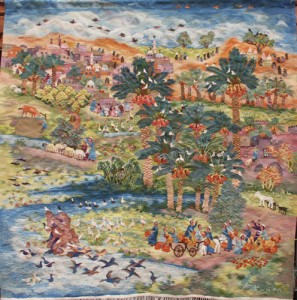
Courtesy of Ramses Wissa Wassef Centre website
Artist, architect and pioneer Ramses Wissa Wasef is one of Egypt’s leading humanists. He came from a family dedicated to the patronage of the arts. His father was a nationalist at a time of turmoil for Egypt under British rule, and Wassef was drawn heavily into the beauty of old Cairo and the architecture of its medieval times.
To mark his centennial, the Tarek Waly Centre has joined forces with the Supreme Council of Culture and the American University in Cairo’s rare books library to celebrate the artist’s life, through an exhibition that will be held at the palace of the arts, part of the Cairo Opera House complex.
The exhibition hopes to bring attention to both Wassef’s work and his life. In addition to showcasing works that are in the AUC’s rare books library, the exhibition will also screen a 25-minute documentary film that features the lives of those touched by Wassef. The film is titled Ayub Al-Haraneya and is directed by both Tarek Waly and Omnia Khalil.
The Tarek Waly Centre for architecture and heritage is naturally interested in Wassef’s work and they describe their own vision as including “cultural continuity” and holding it vital to architectural and urban practices. For the Waly Center, culture is given a prominent role in architecture and its passing from generation to generation.
This vision compliments Wassef’s work beautifully, and the artist famously drew inspiration from the ability of craftsmen to create beauty from their heritage and their own local character. Admiring and promoting Egyptian local work, Wassef drew attention to these practices.
Somewhat of an aesthete, he stressed beauty of form in everything he admired and created. Wassef also famously criticised modern society and its focus on adhering to certain norms and frameworks in art. He spoke of the importance of individualism in art and of the place of art as a universal value and a universal language of communication.
In 1952, he founded, along with his wife Sophie, the Ramses Wissa Wassef Art Centre compound near Giza, to train local craftsmen. The centre has trained generations upon generations of weavers and other craftsmen and continues to operate to this day. Wassef taught architecture and art at the College of Fine Arts in Cairo and chaired the department of architecture until his death in 1974.
The exhibition will be inaugurated on 1 November, and will run to 11 November, with the screening of the documentary film and a series of talks organised by the Tarek Waly Centre.




